The Top-Level OKRs Strategy Survey allows your team to quickly align on the right top-level strategic objectives by using lifecycle theory. We believe that if your company is not using lifecycle theory to set its three-year priorities and annual goals, then you are not doing strategy right. This module makes it easy to identify the right strategy for the current lifecycle stage of the business (or business units) and to recognize and avoid some classic strategic execution traps.
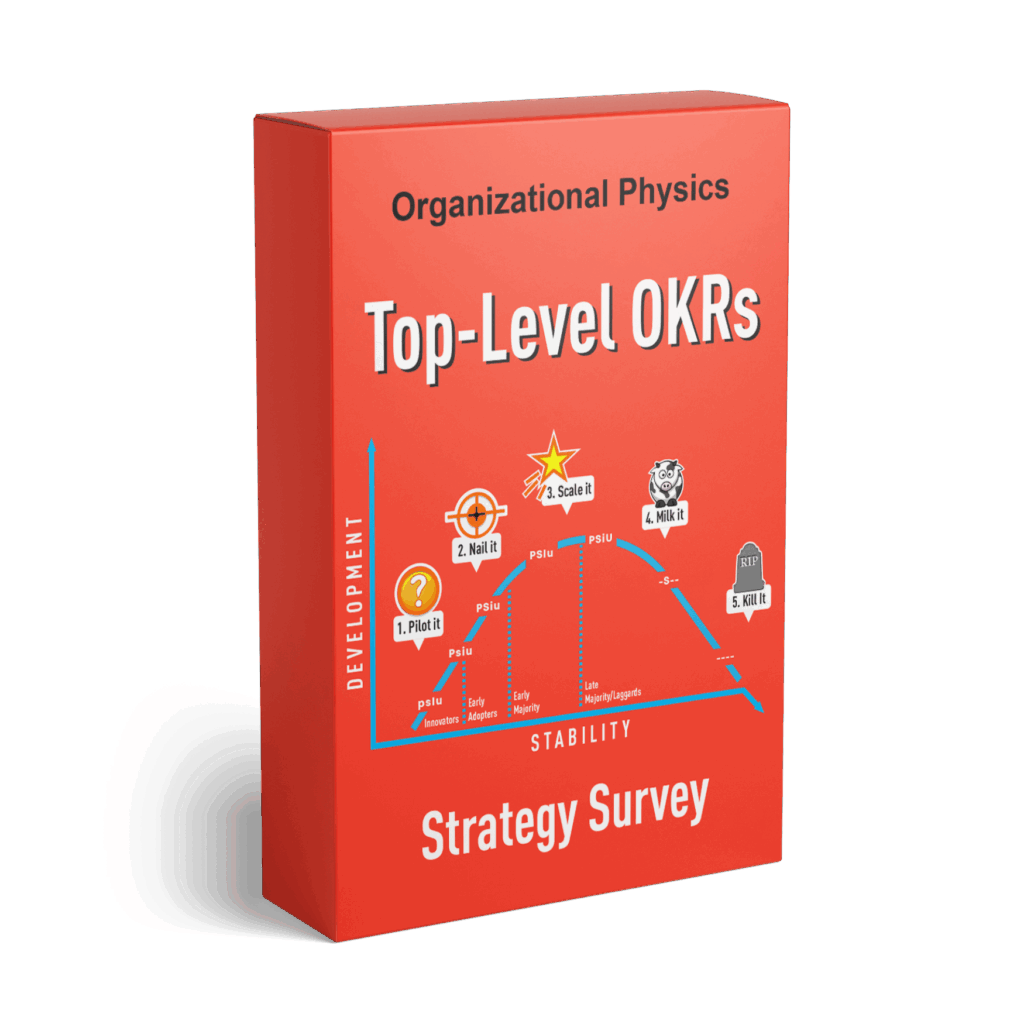
Let’s talk strategy.
How would you rate your company’s current level of clarity and alignment towards the right set of three-year strategic objectives for its lifecycle stage, on a scale of 0 (low) to 5 (high)?
Think for a moment. What score would you give?
If it’s 4 or above — indicating that your strategic priorities are the right ones for your company’s lifecycle stage, everybody in the company “gets it,” and they can see how their individual work supports the strategy — then you can stop reading now. Congrats and keep doing what you’ve been doing!
If it’s 3 or below — indicating that there’s either a lack of clarity on the right strategic priorities, or misalignments in the team’s understanding and buy-in about the right priorities at this time, then please keep reading. What I’m going to share with you will measurably improve company-wide strategic clarity and alignment on the right strategy by 30 to 50% this quarter.
Dive deeper into what makes the Top-Level OKRs Survey a powerful diagnostic tool. This section unpacks the methodology, benefits, and strategic use cases so you can understand exactly how it helps identify and communicate the right stage-dependent strategy.
Have a specific question about the Top-Level OKRs Survey or other Pro Tools?
If you’ve been in the trenches of an expansion-stage company, I don’t have to tell you that it can be surprisingly challenging to truly align a diverse leadership team around a core set of strategic priorities. Sales has its views. Finance has its own. Operations and Customer Success demand to see internal improvements in the customer experience while Product Strategy and Business Development want to push the envelope on what’s possible, and so on.
It’s not as easy as just saying, “Yes, and…” and adding a bunch of unrealistic strategic themes. Real strategy requires real sacrifice. What you are not going to do is just as important as what you are committed to doing to drive your company to its next stage of development.
The risk of getting the top-level strategy wrong can mean the rapid failure of the entire business. In this scenario, the team is busy climbing the wrong mountain for its current stage of development.
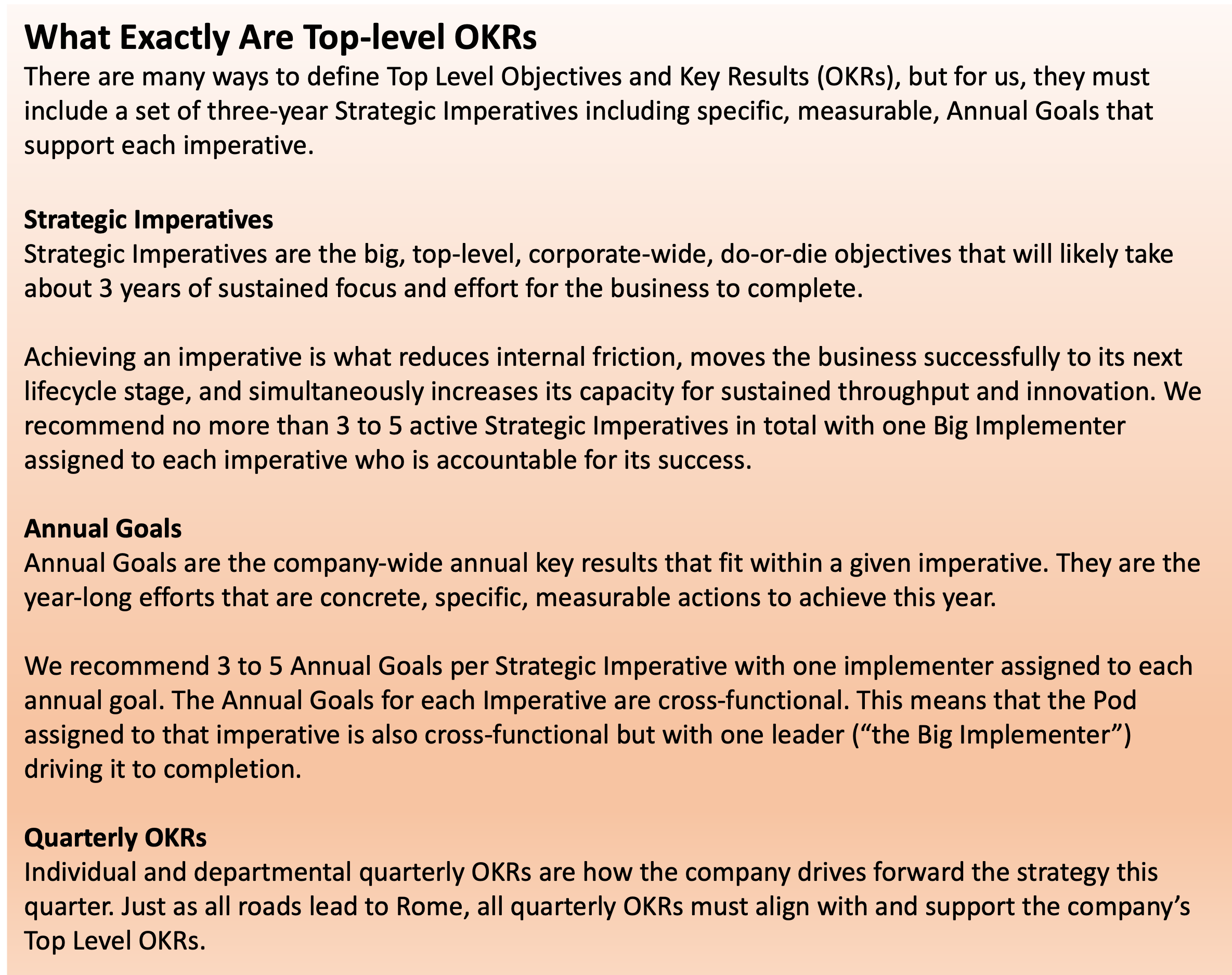
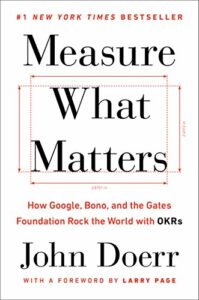 In the book Measure What Matters, famed venture capitalist John Doerr profiles many companies and leaders successfully running an objectives and key results (OKR) program. What’s most interesting to me about the book is that it reinforces how challenging it can be to align a cross-functional leadership team around the most important top-level corporate objectives.
In the book Measure What Matters, famed venture capitalist John Doerr profiles many companies and leaders successfully running an objectives and key results (OKR) program. What’s most interesting to me about the book is that it reinforces how challenging it can be to align a cross-functional leadership team around the most important top-level corporate objectives.
For instance, Mike Lee, co-founder and CEO of MyFitnessPal, says, “We didn’t appreciate how much thought it took to create the right (top-level) company objectives.” And Sundar Pichai, CEO of Google, told Doerr that the leadership team “agonized” over getting its bottom-up OKR process to align with the most important top-level objectives that really mattered.
If your experience is similar — that it takes longer and it is harder than anticipated to align the company around the right top-level objectives and key results — I want you to know that there is a way to get the authentic buy-in of your leadership team on the right set of top-level priorities for your company’s current stage of development and to translate those into focused accountabilities. And you can do it in a matter of hours versus months. The secret is to use a map …
Within Organizational Physics, we have a saying that “strategy starts with where.” Meaning that where a business or business unit currently is in its lifecycle actually dictates what its go-forward strategy must be. Not could be — must be. Jeff Bezos put it perfectly when he said, “You can go as fast as possible through each stage but you can’t skip a stage.”
It can be tricky to navigate new terrain and that’s why I created the Organizational Physics Strategy Map (“Strategy Map”). The Strategy Map is a proven way to translate the complexities of business development into an easy to follow guide. The Strategy Map will help a leadership team to easily orient to the right top-level strategic imperatives and annual goals for the business, and any business units, based on their current lifecycle stage.
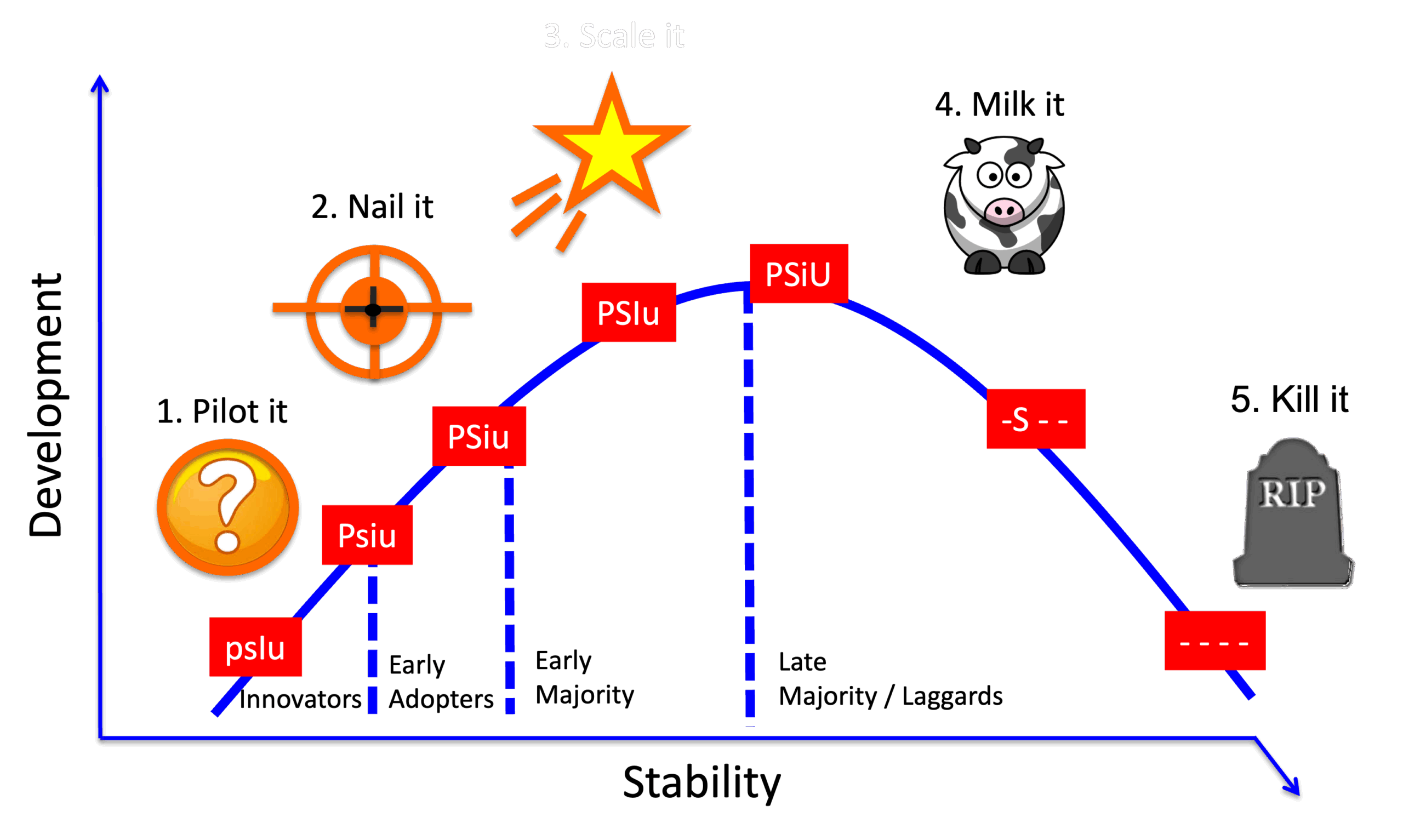
While no map is the actual terrain, a good map can be an incredibly useful tool. This particular map allows a leadership team to quickly all get on the same page about where a business or business unit is in its development; to better understand its current level and type of execution risks; and to align on the right next set of top-level OKRs for the business and/or any business units.
If this Strategy Map is new to you, I highly recommend that you read this white paper Understanding Lifecycle Strategy. It will help you to quickly appreciate lifecycle theory, identify the entry and exit points for each stage, and better understand how to avoid some classic strategic blunders.
The basic idea behind the Strategy Map is really simple. First, identify where a business or business unit is located now on this map and how well-aligned its product, customer, and execution capabilities are. Because the team is using the same visual map, it makes identifying strategic misalignment areas much easier to spot and much faster to reconcile. The result is shared consciousness on the right next stage of strategic imperatives that will drive the business to its next lifecycle stage.
For example, if a business is currently in the mid-Nail It stage, then its top-level OKRs must reflect what it must do to drive into late Nail It and then early Scale It. It would be a strategic blunder to try to bypass the late Nail It stage and attempt premature scaling (this particular execution risk is called the Flame Out, by the way).
Once the right top-level strategic imperatives are identified based on the current lifecycle stage of the business, the team then works through the annual goals to support each imperative, followed by company-wide individual and departmental OKRs for the coming quarter. Just as all roads lead to Rome, each set of individual and departmental quarterly OKRs must directly or indirectly support the top-level strategic objectives.
As an organizational scaling coach, I have helped many hundreds of leadership teams to align on the right top-level OKRs. It is very common that, before I show up, the team has been struggling for many months to get alignment on the right top-level priorities and to translate those priorities into accountabilities and rapid execution. Then I show up, and in a few hours, there’s suddenly deep and ready alignment.
Part of the reason for this is that I’m an outsider. I can hear all sides and help guide the team to the right strategic outcomes. But a bigger reason why I am able to rapidly align a team on what seem to be intractable differences of opinion is that I first survey the team to identify where a business or any business units are in their lifecycle development. Once that shared recognition is achieved, setting strategy is actually pretty easy. This is because there’s now alignment on the fact that different stages require different strategic goals.
I have recently decided to make the survey tool that I use in my consulting practice available to other coaches and leadership teams. The tool is called the Top-Level OKRs Strategy Survey. It is easy to deploy and to see immediate and rapid results in strategic clarity and alignment across a cross-functional team.
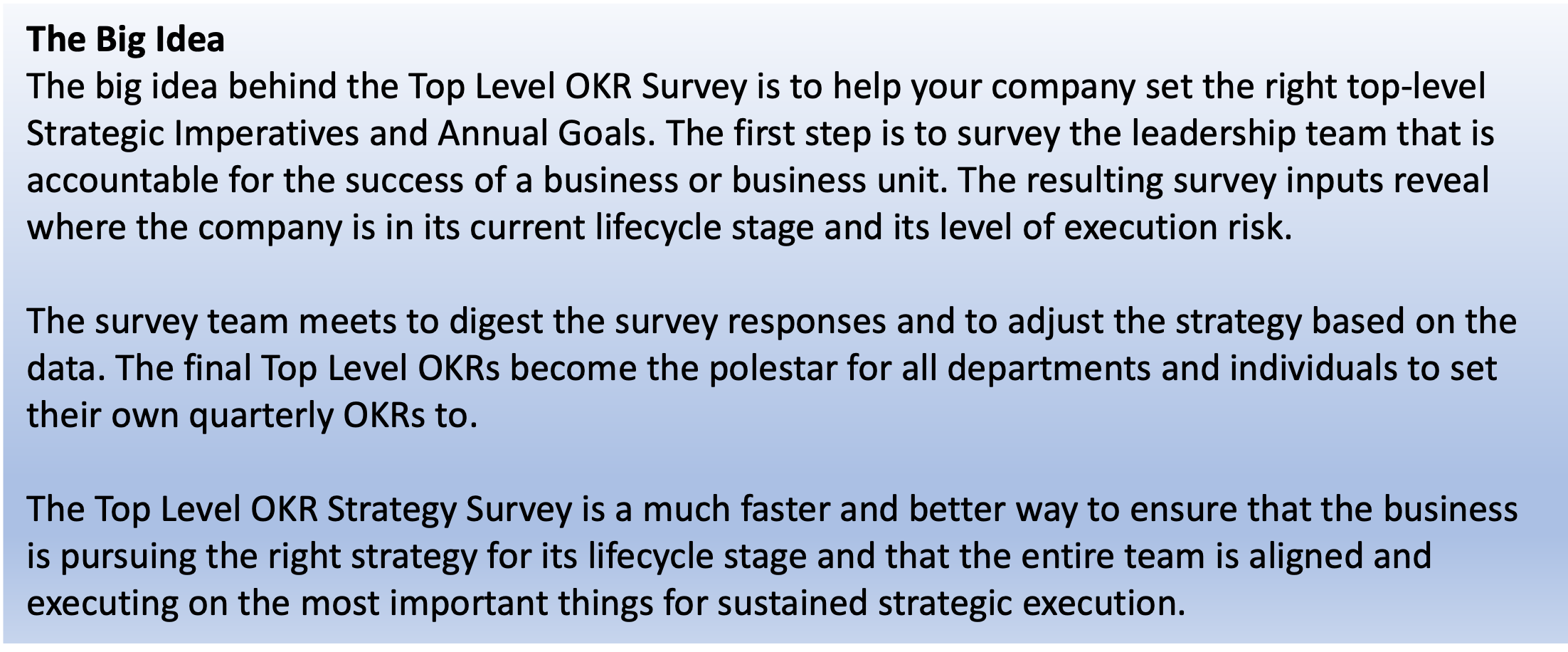
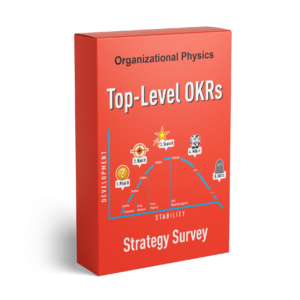
The Top-Level OKR Survey is sent either to the leadership team of the entire company, or to the cross-functional team that is accountable for the strategic execution of a given business unit. Target 7 to 12 survey respondents total. It is critical that this be a cross-functional group (don’t just survey the growth hackers or the ops team).
After you register for the free 30-day trial, take these steps:
** Note that quarterly OKRs are not part of the Top-Level OKR Strategy Survey. The team can use our quarterly OKRs template or its existing OKR management software to set and manage individual and departmental quarterly OKRs.
The benefits of the Top-Level OKR Strategy Survey are significant. What is the benefit of getting your strategy right for your current lifecycle stage? And what is the benefit of being able to communicate that strategy clearly so that everyone “gets it”? In my view, setting and communicating strategy is the #1 job of every effective CEO.
Of course, an effective CEO or business unit head does not set strategy in isolation. They must take into account a wide variety of data sources and perspectives. The Top-Level OKR Strategy Survey makes this much easier to do, in a way that gives the team the opportunity to shape the strategy upstream before it is decided upon. Their resistance to implementing the strategy is therefore much lower. It’s no longer the “CEOs strategy” it’s “our best strategy” and the team is all on the same page about why this is our strategy.
The benefits of setting strategy using the Top-Level OKR Strategy Survey:


The risk to you is the time and energy required to learn the Top-Level OKRs program and to run a real or a dummy survey to kick the tires. It’s easy to mitigate this risk with a free 30-Day trial.
However, there could also be a perceived risk that by surveying the team in this manner, you may discover that your current strategy is out of synch with the company’s lifecycle stage and that you are headed into a strategic blunder.
Of course, this is only a risk to a CEO who wants to pretend that everything is hunky-dory. Great CEOs get these kinds of potential misalignment issues on the table quickly so they can work to resolve them. We believe in transparency. And you must also believe in transparency if this process is going to work well for your company.
The true risk is the cost of having a misaligned strategy. Or one that some members of the team haven’t fully understood or bought into. I think you’ll agree with me that these costs can be extreme to the entire enterprise.
Conversely, the ROI of getting it right is significant. When you can quickly and easily align a team on a shared reality, then setting the right strategic imperatives for the lifecycle stage of a business is straightforward. The light bulb has gone off for everyone. Then it’s a matter of defining and honing in on the strategy and getting after it together as a team. But it starts with the polestar. It starts with the shard recognition of where we are at now and thus, what our next-stage strategy must be.
If you’ve read this far, you should have enough information to register and launch your first survey. Take the survey yourself first so that you’ll have the confidence to send it out to the leadership team when the time is right.
Since this is a new tool, you’ll need to take it for a test drive to really understand it and see if it’s right for your organization. After you register, we recommend that you launch a dummy survey, enter some sample data, and then close the survey to view the reporting. Thanks and we look forward to connecting with you in the members area! Click below to begin your 30-day free trial (new customers only). Cancel anytime.
Let’s build your high-performance organization together.
Organizational Physics® empowers CEOs and leadership teams to scale with clarity and confidence. By applying universal principles and proven frameworks, we help organizations improve internal performance, accelerate growth, and build resilient structures for the long term.
© Copyright Organizational Physics Inc.